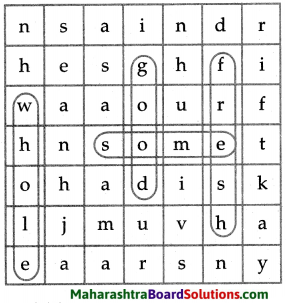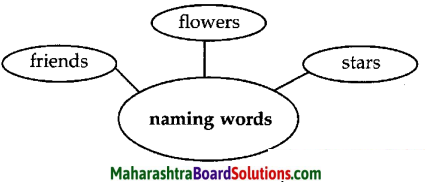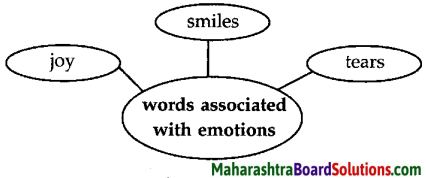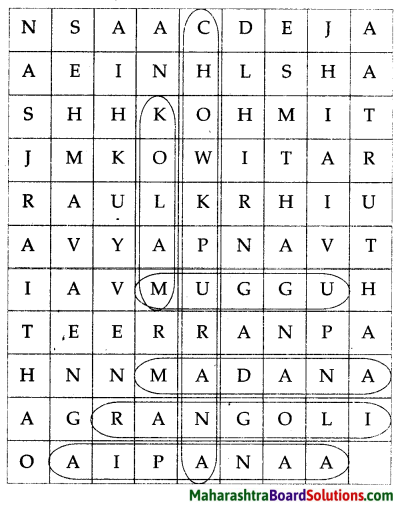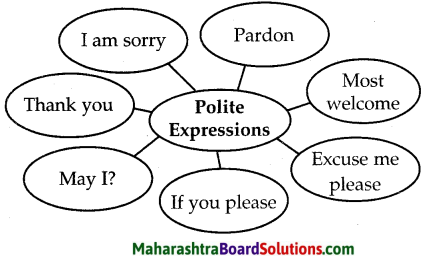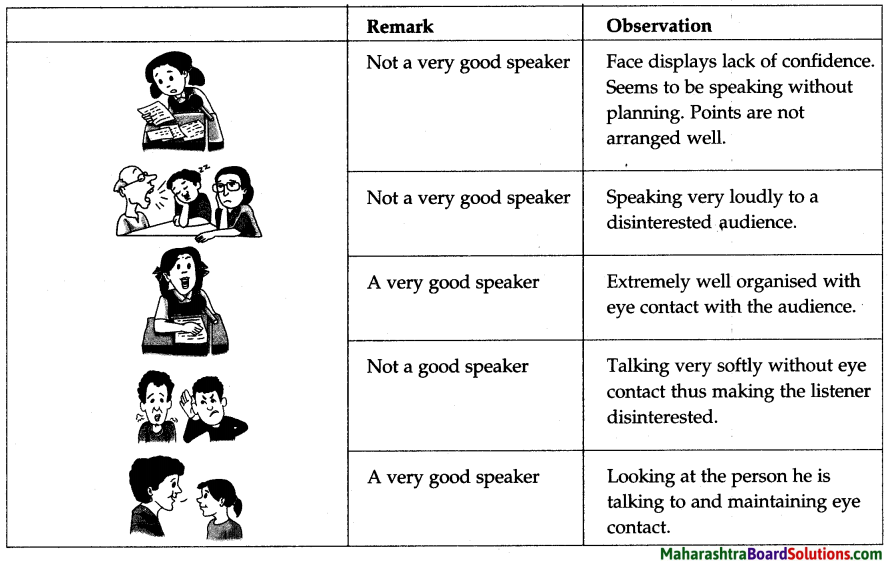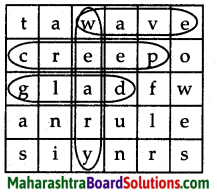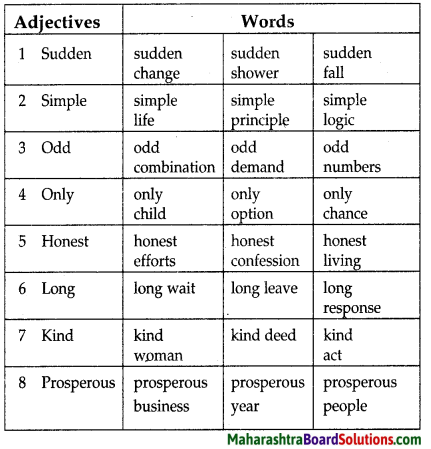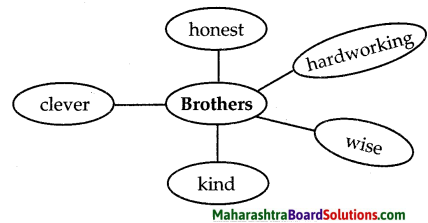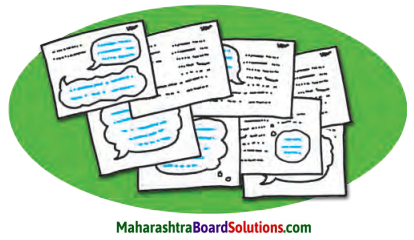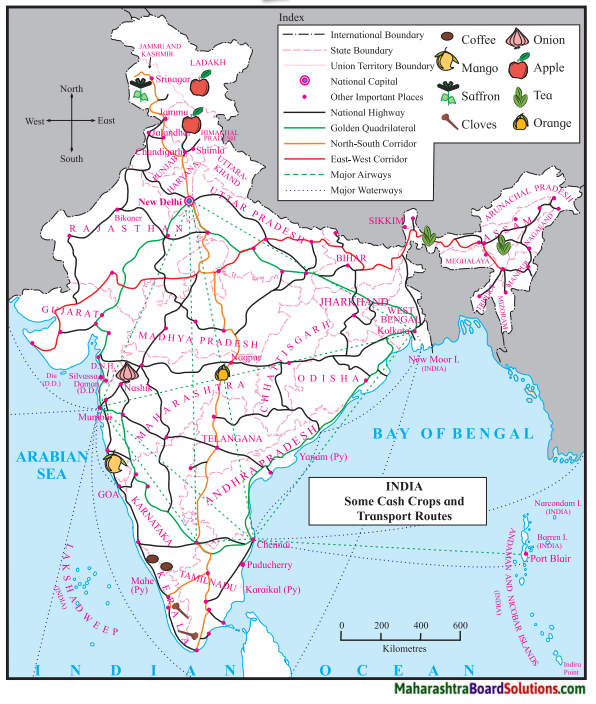Balbharti Maharashtra State Board Class 5 Environmental Studies Solutions Chapter 3 The Earth and its Living World Notes, Textbook Exercise Important Questions and Answers.
5th Standard EVS 1 Lesson Number 3 Question Answer The Earth and its Living World Maharashtra Board
Std 5 EVS 1 Chapter 3 Question Answer
1. What is the solution?
Question 1.
Dark patches appear on the skin after exposure to the sun.
Answer:
Dark patches due to sun’s rays are called sunspots which can be taken care in a natural way by applying slices of fresh lemon on it for 10-15 minutes or by applying aloe vera gel twice a day.

2. Use your brainpower!
Question (a)
Why are microorganisms important?
Answer:
Microorganisms live in the soil and do the work of decomposing the dead plants and animals. If there were no microorganisms then the dead plants and animals would not get decomposed, they would have got accumulated and the soil would not become fertile.
Question (b)
Think about all the foodstuffs obtained from the sea. Find more information and write ten lines about them.
Answer:
Question Personal response.
3. Answer the following in one sentence:
Question (a)
What are clouds made of?
Answer:
Clouds are made up of very fine droplets of water which are small and light.
Question (b)
What is meant by biosphere?
Answer:
Living things occupy parts of the lithosphere, hydrosphere, and atmosphere. Living things and all the parts they occupy are together called the biosphere.

Question (c)
Make a list of the land forms you see in your surroundings and give a description of any two of them.
Answer:
(Personal response) Landforms e.g. mountain, hill, hillock, valley, plains, plateaus, river etc. (Students are supposed to write their own answers)
4. In the following sentences, underline the words that refer to landforms.
Question 1.
In the following sentences, underline the words that refer to landforms.
Answer:
(a) Anil lives at the foot of a hill.
(b) Ria lives in the plateau region.
5. Write a note about the following:
Question (a)
Evaporation:
Answer:
Due to the heat of the sun, the water from the earth’s surface goes into vapour state forming fine droplets of water which are small and light. This process is called evaporation.
Question (b)
Condensation:
Answer:
The process when vapour turns into water on cooling to form drops of water it is called as condensation.
Question (c)
The water cycle:
Answer:
- Evaporation of water from the earth due to the heat of the sun, forms water vapour.
- This vapour is light and moves up in the atmosphere and forms clouds.
- When these droplets join together and form bigger drops they become heavy and falls down on the earth in the form of rain.
- This process of evaporation, condensation and rainfall go on in a continuous cycle.
- This is known as nature’s water cycle.

6. Give two examples of each:
Question (a)
Weather-related events
Answer:
Clouds, rain
Question (b)
Sources of water
Answer:
River, lake
7. Draw a labelled diagram showing the:
Question 1.
Water cycle
Answer:
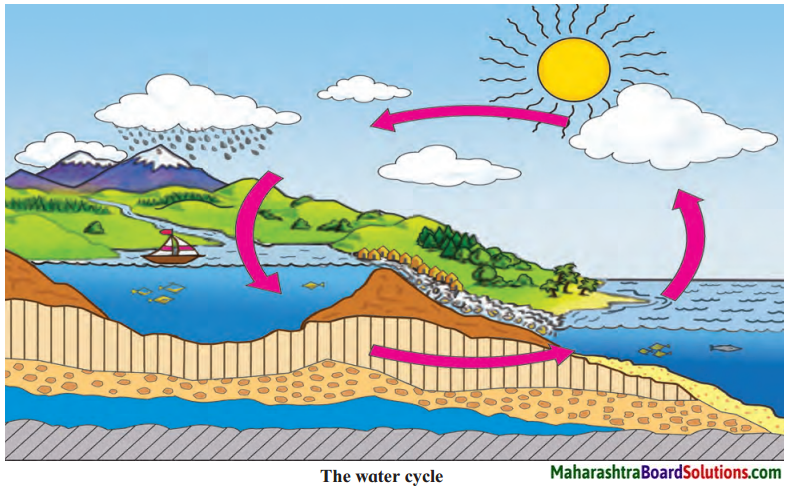
Question 2.
The earth’s atmosphere
Answer:

Question 3.
The spheres of the earth
Answer:
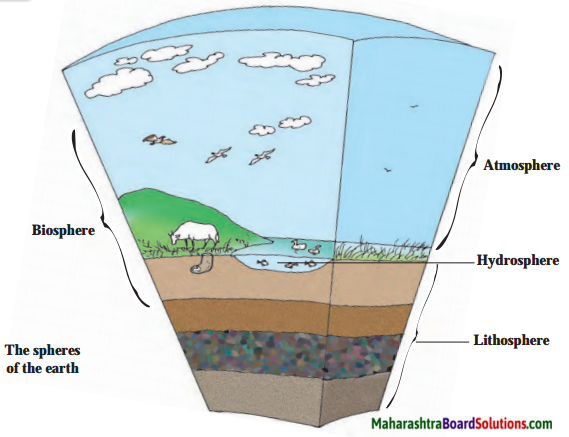
Environmental Studies Part 1 Standard 5th Solutions Chapter 3 The Earth and its Living World Additional Important Questions and Answers
Fill in the blanks with the correct answers from the options given below:
Question 1.
The earth’s crust is mainly made up of …………….. .
(a) soil
(b) rock
(c) animals
Answer:
(b) rock
Question 2.
The earth’s crust and a small hard portion of the layer under it is called the ………………. .
(a) hydrosphere
(b) atmosphere
(c) lithosphere
Answer:
(c) lithosphere

Question 3.
About ……………….. of the earth’s surface is covered by land while about ………………… is covered with water.
(a) one third
(b) one fourth, two third
(c) three fourth
Answer:
(b) one fourth, two third
Question 4.
The envelope of air around the earth is called the ……………… .
(a) lithosphere
(b) atmosphere
(c) biosphere
Answer:
(b) atmosphere
Question 5.
There are huge blocks of ice floating in the sea called ……………….. .
(a) glacier
(b) blockice
(c) iceberg
Answer:
(c) iceberg
Question 6.
The earth is surrounded by the …………………. .
(a) atmosphere
(b) lithosphere
(c) hydrosphere
Answer:
(a) atmosphere
Question 7.
There are ………………. things on land, air and water.
(a) non-living
(b) living
(c) rocks
Answer:
(b) living
Question 8.
The ……………….. is the cause of many natural processes on the earth.
(a) moon
(b) planets
(c) sun
Answer:
(c) sun

Question 9.
The ……………… spreads in all the other three spheres.
(a) biosphere
(b) atmosphere
(c) lithosphere
Answer:
(a) biosphere
Question 10.
The earth’s crust is ………………….. .
(a) soft
(b) marshy
(c) hard
Answer:
(c) hard
Question 11.
A vast continuous stretch of land is called a ………………… .
(a) sea
(b) ocean
(c) continent
Answer:
(c) continent
Question 12.
The land on earth is divided into ………………… continents.
(a) one
(b) two
(c) seven
Answer:
(c) seven
Question 13.
………………….. is the largest continent.
(a) Africa
(b) Asia
(c) Australia
Answer:
(b) Asia
Question 14.
…………….. is the smallest continent.
(a) Africa
(b) Asia
(c) Australia
Answer:
(c) Australia
Question 15.
Ocean water is …………………. .
(a) salty
(b) sweet
(c) bitter
Answer:
(a) salty
Question 16.
There are ……………….. oceans.
(a) one
(b) five
(c) seven
Answer:
(b) five
Question 17.
The land along the margins of an ocean is called the ……………….. region.
(a) coastal
(b) rainy
(c) mountainous
Answer:
(a) coastal

Question 18.
Stream water is ……………….. and not salty.
(a) bitter
(b) fresh
(c) salty
Answer:
(b) fresh
Question 19.
……………….. are smallest forms of water streams.
(a) Rills
(b) Brooks
(c) Rivers
Answer:
(a) Rills
Question 20.
……………… are biggest forms of water streams.
(a) Rills
(b) Brooks
(c) Rivers
Answer:
(c) Rivers
Question 21.
A river cascades down a sudden drop to form a ……………….. .
(a) lake
(b) waterfall
(c) glacier
Answer:
(b) waterfall
Question 22.
All rivers eventually flow into the …………………. .
(a) lake
(b) waterfall
(c) ocean
Answer:
(c) ocean
Question 23.
A water body formed by water collecting naturally in a low-lying area of land is called a …………… .
(a) ocean
(b) lake
(c) river
Answer:
(b) lake
Question 24.
Many lakes and wells get water from underground …………………. .
(a) lakes
(b) springs
(c) mines
Answer:
(b) springs
Question 25.
As we go higher from the earth’s surface, the air in the atmosphere becomes ………………. .
(a) rarer
(b) thicker
(c) solid
Answer:
(a) rarer
Question 26.
The atmosphere consists of a mixture of ……………….. .
(a) liquid
(b) solid
(c) gases
Answer:
(c) gases
Question 27.
As we go higher in the troposphere, it becomes ……………….. .
(a) hotter
(b) humid
(c) cooler
Answer:
(c) cooler

Question 28.
Almost all the water vapour in the atmosphere is contained in the ………………. .
(a) troposphere
(b) stratosphere
(c) mesosphere
Answer:
(a) troposphere
Question 29.
In the lower part of the stratosphere, there is a layer of a gas called ……………….. .
(a) oxygen
(b) ozone
(c) nitrogen
Answer:
(b) ozone
Question 30.
…………………….. rays coming from the sun are harmful for living things.
(a) Ultraviolet
(b) Infrared
(c) Electric bulb
Answer:
(a) Ultraviolet
Question 31.
Water on the earth ……………………….. continuously due to the heat of the sun.
(a) condenses
(b) evaporates
(c) melts
Answer:
(b) evaporates
Question 32.
Water vapour is ………………. than air, it rises up into the atmosphere.
(a) lighter
(b) heavier
(c) bigger
Answer:
(a) lighter
Question 33.
The polar bear is seen only in the …………………. polar regions.
(a) rain bound
(b) windblown
(c) snowbound
Answer:
(c) snowbound
Question 34.
Zebras are found in ………………….. .
(a) Africa
(b) India
(c) Australia
Answer:
(a) Africa
Question 35.
Kangaroos are found only in …………………… .
(a) Africa
(b) India
(c) Australia
Answer:
(c) Australia
Question 36.
This ………………… world constitutes the biosphere.
(a) living
(b) non-living
(c) material
Answer:
(a) living
Give two examples of each:
Question 1.
Continents
Answer:
Asia, Africa
Question 2.
Oceans
Answer:
The Atlantic, Pacific Ocean
Question 3.
Part of the ocean
Answer:
Sea, Gulf
Question 4.
Animals found in regions of hot climates
Answer:
Elephant, Lions

Question 5.
Answer in one word:
Answer:
- The cause of many natural processes on the earth.
- Largest Continent
- Smallest Continent
- Uneven land in different places.
- Smallest streams
- Biggest Streams
- Place where river cascades
- Layer of gas in the stratosphere.
- Animals found only in Australia.
Answer:
- Sun
- Asia
- Australia
- Landforms
- Rills
- Rivers
- Waterfall
- Ozone
- Kangaroos
Question 4.
In the following sentences, underline the words that refer to landforms.
Answer:
- Ganga is India’s longest river.
- Esselworld is situated near the sea shore.
- Andaman and Nicobar are beautiful islands.
- Agriculture is the main occupation in the plains.
Answer the following in one sentence:
Question 1.
What is a coastal region?
Answer:
The land along the margins of an ocean is called a coastal region.

Question 2.
What is a lake?
Answer:
A water body formed by water collecting naturally in a low lying area of land is called a lake.
Question 3.
What is meant by hydrosphere?
Answer:
The water or ice that occupies the earth’s surface, groundwater and the water vapour in the atmosphere together form the earth’s hydrosphere.
Question 4.
Name the layers of the atmosphere.
Answer:
The layers of the atmosphere are troposphere, stratosphere, mesosphere, ionosphere and exosphere.
Question 5.
What is the atmosphere made up of?
Answer:
The atmosphere mainly consists of a mixture of gases, namely nitrogen, oxygen, water vapour and carbon dioxide.
Question 6.
Which three spheres envelope the earth?
Answer:
The hydrosphere, lithosphere and atmosphere envelope the earth.
Question 7.
Which sphere is present in all the three spheres?
Answer:
The biosphere spreads in all the three spheres.
Question 8.
What portion of the earth is land?
Answer:
About a third of the surface of the earth consists of land.

Question 9.
What is a continent?
Answer:
A vast continuous stretch of land is called a continent.
Question 10.
Into how many continents is the land on earth divided?
Answer:
Land on earth is divided into seven continents.
Question 11.
Name the seven continents of the earth?
Answer:
The seven continents are Asia, Europe, Africa, North America, South America, Antarctica and Australia.
Question 12.
Which is the largest and the smallest continent?
Answer:
Asia is the largest continent and Australia is the smallest continent.
Question 13.
Name the five oceans of the earth.
Answer:
The five oceans are the Atlantic, Pacific, Artie, the Southern Ocean and the Indian Ocean.
Question 14.
Name some water bodies that form along the coastal region.
Answer:
Sea, bay, gulf, strait7, creek8 etc. are some water bodies formed along the coastal region.
Question 15.
How are rivers formed?
Answer:
Rills, brooks9, streams join each other to form rivers.
Question 16.
What is a waterfall?
Answer:
In some places, a river cascades down a sudden drop. This forms a waterfall.
Question 17.
Where do rivers end?
Answer:
All rivers eventually flow into the ocean.

Question 18.
What is snow?
Answer:
Water particles in the cloud freeze and in the cold regions, they come down in the form of snow.
Question 19.
What are icebergs?
Answer:
Huge blocks or mass of ice floating in the sea are called icebergs.
Question 20.
What is ground water?
Answer:
There is a lot of water stored in the underground layers of rock. This water is called ground water.
Question 21.
What is hydrosphere?
Answer:
The water or ice that occupies the earth’s surface, ground water and the water vapour in the atmosphere together form the earth’s hydrosphere.
Question 22.
What is atmosphere?
Answer:
The envelope of air around the earth is called the atmosphere.
Question 23.
Which layer of the atmosphere is closest to the surface of the earth?
Answer:
The troposphere is closest to the surface of the earth.
Question 24.
What happens to the air as we go higher in the troposphere?
Answer:
As we go higher in the troposphere the air becomes rarer and cooler.

Question 25.
What is the ozone layer?
Answer:
In the lower part of the stratosphere, there is a layer of a gas called ozone.
Question 26.
How is ozone layer useful for the living things on earth?
Answer:
Ultraviolet rays coming from the sun are harmful for living things, but the ozone layer absorbs them and protects the living world from those rays.
Question 27.
In which region are elephants and lions found?
Answer:
Elephants and lions are found in regions of hot climate.
Question 28.
Where are kangaroos found?
Answer:
Kangaroos are found only in Australia.
Question 29.
Where are polar bears found?
Answer:
Polar bears are seen only in the snowbound polar regions.
Give geographical reasons:
Question 1.
As we go higher in the troposphere it becomes cooler.
Answer:
1. The surface of the earth gets heated due to the heat of the sun.
2. So, the air near the surface is the hottest.
3. Therefore as we go higher in the troposphere it becomes cooler.

Question 2.
All weather-related phenomena take place in the troposphere.
Answer:
1. Almost all water vapour in the atmosphere is present in the troposphere.
2. Therefore, all weather related phenomena take place in the troposphere.
Question 3.
Mountaineers carry oxygen in cylinders when they climb mountains that are more than 5000 m high.
Answer:
1. As we go higher from the surface of the earth, the air in the atmosphere becomes rarer.
2. Therefore, mountaineers carry oxygen in cylinders when they climb mountains that are more than 5000 m high to get sufficient supply of oxygen.
Answer briefly:
Question 1.
What is a glacier?
Answer:
- In cold regions, when layers of snow pile up on the ground, they form ice.
- When such layers of ice pileup in a low lying area, they become enormous in size.
- This huge mass slips down a slope at a very slow speed.
- This is called a glacier.
Question 2.
What is groundwater? How can we obtain it?
Answer:
- There is a lot of water stored in the underground layers of rock.
- It is called groundwater.
- We can obtain it by means of dug wells and bore wells.
- Many lakes and wells get water from underground springs.
Question 3.
Explain ‘troposphere’.
Answer:
- The layer of air that extends from the earth’s surface to a height of about 13 km is called the troposphere.
- The conditions in the troposphere change continuously. As this layer touches the surface of the earth, the living world gets greatly affected.
- As we go higher in the troposphere, the air gets cooler and rarer.
- Almost all the water vapour in the atmosphere is contained in the troposphere. That is why, all weather-related phenomena such as formation of clouds, rain, fog, winds and storms takes place in troposphere.

Question 4.
How do we get rain?
Answer:
- As the water vapour is lighter than air, it rises high up into the atmosphere.
- As it goes higher, it cools and condenses into fine droplets of water.
- These droplets are so small and light that they float in the atmosphere forming clouds.
- These small droplets join together and form bigger drops that are heavy.
- These heavy drops of water cannot float, so they fall down on the earth in the form of ‘rain’.
Write a note about the following:
Question 4.
Stratosphere:
Answer:
- Beyond the troposphere, up to a height of about 50 km from the earth is the layer called the stratosphere.
- In the lower part of the stratosphere, there is a layer of gas called ozone.
- Ultraviolet rays coming from the sun are harmful for living things.
- But the ozone layer absorbs them and protects the living world from those rays.
Use your brain power!
Question 1.
In which layer of the atmosphere do we see the rainbow?
Answer:
We see the rainbow in the troposphere.
Can you tell?
Question 1.
Where do you get water from?
Answer:
Rain

Question 2.
Where do we lay the foundation of buildings?
Answer:
Lithosphere
Question 3.
Which need is met through breathing?
Answer:
Breathing helps us to keep us alive. We take in oxygen from the air and give out carbon dioxide.
Question 4.
From where does the earth get light and heat?
Answer:
Sun
Question 5.
Make as long a list as you can of all the living things you see in the lithosphere, hydrosphere and atmosphere.
Answer:
| Lithosphere |
Hydrosphere |
Atmosphere |
| 1. Trees |
1. Fishes |
1. Birds |
| 2. Rabbit |
2. Whales |
2. Butterflies |

Glossary:
- vast – immense
- margins – the edge or border of something.
- phenomena – situation or fact
- snowbound – covered in snow
- crust – the tough, outer part.
- cascades – pour ownwards rapidly.
- strait – a narrow passage of water connecting two seas
- creek – a stream or minor tributary of water
- brook – a C small stream.
- float – move and honer on the surface of water
- evaporation – process of liquid changing into a gas.
- decomposing – decaying
- accumulated – gathered together.
Class 5 Environmental Studies Questions and Answers:
![]()
![]()
![]()
![]()
![]()
![]()
